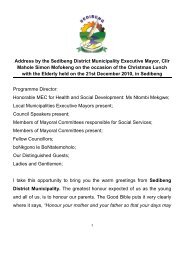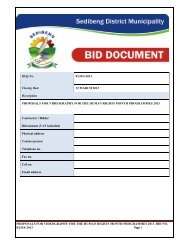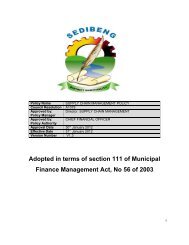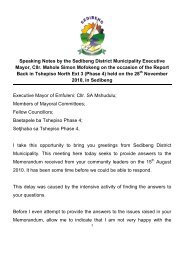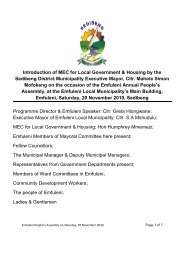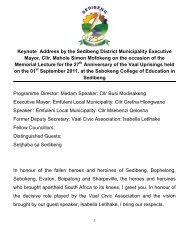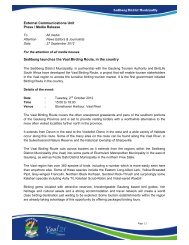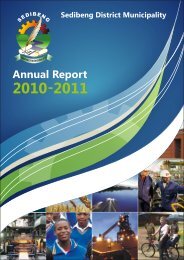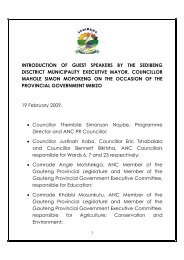Chapter 11 - Sedibeng District Municipality
Chapter 11 - Sedibeng District Municipality
Chapter 11 - Sedibeng District Municipality
You also want an ePaper? Increase the reach of your titles
YUMPU automatically turns print PDFs into web optimized ePapers that Google loves.
SDM w ill assist its Local Municipalities to systematically formulate and implement a<br />
Road Signs Management System as defined in the South African Road Signs<br />
Manual, Volume 2, <strong>Chapter</strong> 16.<br />
SDM w ill assist its Local Municipalities w ith improving signage and information<br />
services to tourist attractions and especially in the run up to the 2010 World Cup<br />
Soccer tournament.<br />
SDM w ill assist its Local Municipalities w ith the ongoing maintenance or replacement<br />
of outdated or damaged signs in <strong>Sedibeng</strong>. This w ill be done in terms of the phased<br />
approach developed as part of the traffic signs audit done recently.<br />
SDM w ill assist its Local Municipalities to identify specific locations w here road<br />
markings have a higher than normal impact on the safety of road users, such as at<br />
stop signs, traffic signals or pedestrian crossings (especially w here learners cross a<br />
road section). These locations w ill be prioritised based on amongst other<br />
considerations the condition of the road markings,w here after high quality, durable<br />
paint w ill be used for road markings at such locations.<br />
9.6 Upgrading and Maintenance of Roads in the Strategic Roads Netw ork<br />
(a)<br />
Background<br />
Routine Road Maintenance (RRM) can be defined as those treatments that are<br />
applied to a pavement, in order to keep the pavement functioning properly. As such,<br />
routine maintenance is sometimes referred to as “reactive maintenance.” This<br />
suggests that it is w ork that is performed as a reaction to a specific distress. Routine<br />
maintenance is performed on pavements as they begin to show signs of deterioration,<br />
but is generally considered to be a w asted effort on pavements that are severely<br />
distressed.<br />
Filling a pothole is an example of a routine maintenance activity. It cannot be<br />
scheduled before the pothole appears, and it should not be left unattended once the<br />
pothole has developed. How ever, if there are too many potholes present, a more<br />
comprehensive repair may be required. In addition to pothole repair, routine<br />
maintenance treatments applied to pavements include edge patching, crack sealing<br />
and filling, and shoulder repair.<br />
Routine maintenance w orks are divided into the follow ing types:<br />
• Pavement: These are w orks responding to (minor) pavement defects caused<br />
by a combination of traffic and environmental effects, for example, crack<br />
sealing, patching, edge repair, shoulder re-gravelling and grading.<br />
• Non-pavement: These are w orks that exclude pavement repair, examples are<br />
clearing side drains and culverts, vegetation control, line-marking, road signs<br />
replacement/repair and guard rail replacement/repair.<br />
(b)<br />
Problem Statement<br />
SDM DITP, 2008 to 2013 141 31 Aug 2010



